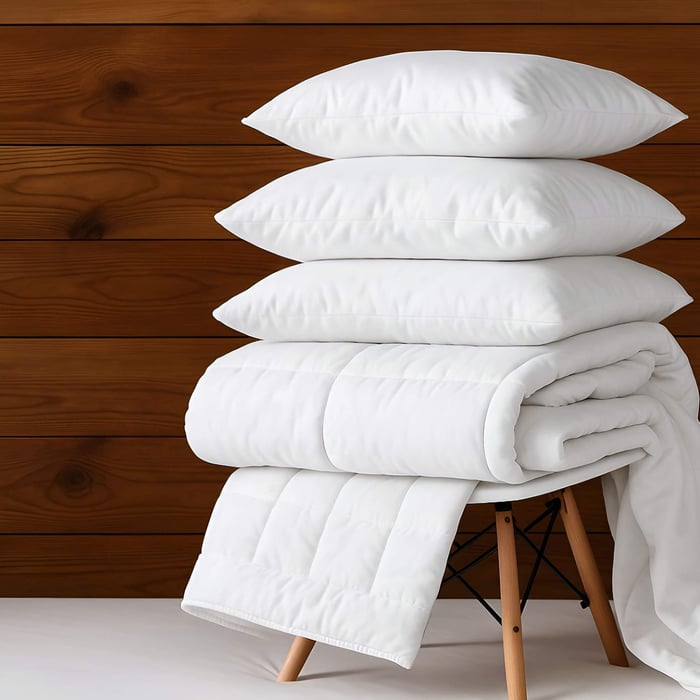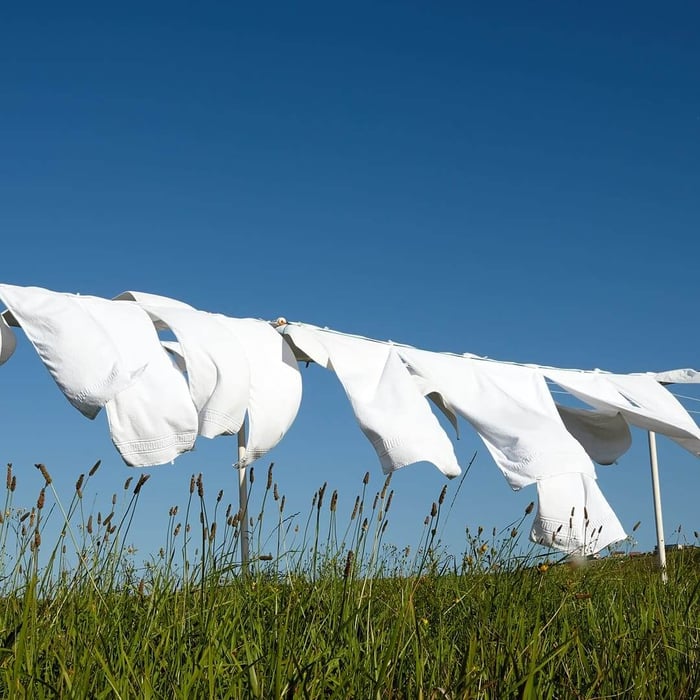Table of Contents
- It's true; down alternative is ruining your sleep.
- The Hidden Toxins & Synthetic Bedding Dangers in Down Alternative Bedding ☠️
- The Real Reason You Can’t Get Comfortable at Night
- Why Wool Is the Real Deal: Understanding Wool Comforter Benefits
- Plastic Is Ruining Your Sleep (and Your Home)
- Real Sleep Comes from Real Materials
- FAQs
It's true; down alternative is ruining your sleep.
Here's why down alternative is ruining your sleep.
You can do everything “right” before bed — cool room, clean sheets, no screens — and still wake up hot, clammy, or unrested.
Often, the problem isn’t your sleep habits.
It’s what you’re sleeping under.
Down alternative and polyester comforters are quietly working against your body all night long. They trap heat. They hold moisture. And despite labels like “cooling gel fiber” or “breathable microfiber,” they’re doing the opposite of what real sleep needs.
Strip away the marketing, and most down alternatives are exactly the same thing:
plastic fibers, engineered to mimic comfort — not support sleep.
So let's call them what they really are: plastic disguised as fabric.
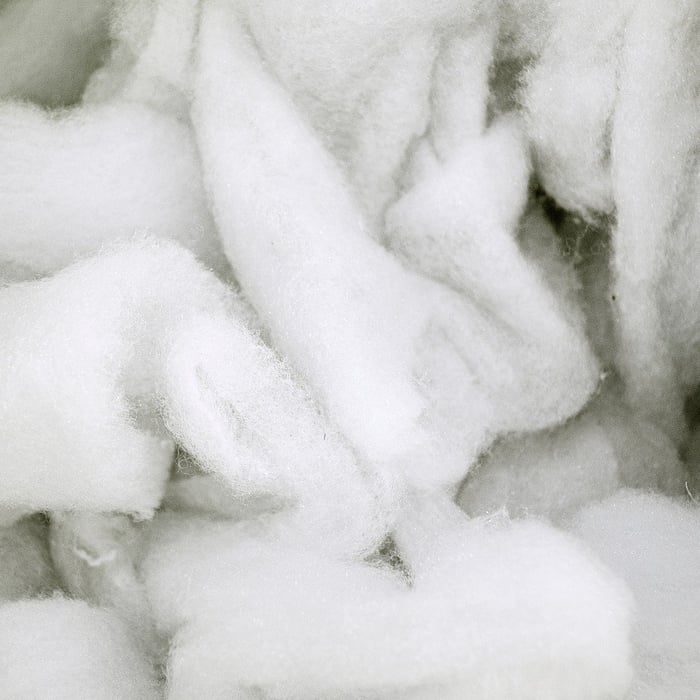 You’ll see it called down alternative, microfiber, polyfill, recycled fill, or even vegan down — but no matter the name, it’s all the same thing: plastic.
You’ll see it called down alternative, microfiber, polyfill, recycled fill, or even vegan down — but no matter the name, it’s all the same thing: plastic.What Is Down Alternative, Really?
Down alternative comforters are marketed as a replacement for natural materials like feather and down or wool. It’s often touted as hypoallergenic, affordable, and easy to care for. But beneath the clever branding lies the truth: it’s plastic.
Usually made from polyester or other synthetic fibers, down alternative is just a fancy way of saying your comforter is filled with chemically-produced, petroleum-based material.
You’ll see it called down alternative, microfiber, polyfill, recycled fill, or even vegan down — but no matter the name, it’s all the same thing: plastic.
These synthetic fibers trap heat, shed microplastics, and break down over time — the opposite of what natural wool does. But it's the use of plastic that's why down alternative is ruining your sleep.
If you’ve ever wondered why you wake up sweaty or struggle to stay comfortable throughout the night, this might be the reason.
Organic Wool Duvet Insert & Bedding Set | Sustainable & Regenerative | Made in New Zealand

$475.15
$559.00
Cooler Nights & Deeper Sleep — All Year Long Looking for the perfect organic wool duvet insert and wool bedding set? This complete bundle includes both the duvet insert and cover. (The insert uses the same breathable, temperature-regulating design as… Read more
Sleeping under a down alternative comforter is like wrapping yourself in a shower curtain—trapping heat and moisture instead of allowing your body to breathe naturally.Plastic in Your Bedding = Poor Sleep
Let’s break it down; why down alternative is ruining your sleep?
Plastic, no matter how cleverly disguised, cannot regulate temperature. It traps heat and holds onto moisture, creating the perfect storm for restless nights. You’ll find yourself overheating, sweating, and flipping your blanket on and off, searching for relief. That’s because synthetic fibers lack the natural properties that make materials like wool the ultimate choice for bedding.And those "cooling gel" and "breathable microfiber" labels? They’re just marketing gimmicks.
No amount of cooling additives can change the fact that plastic does not—and cannot—help your body maintain its optimal temperature for deep, restorative sleep.
Why Down Alternative Comforters Traps Heat 🔥
If you’ve ever woken up drenched in sweat, unable to find a comfortable temperature, your down alternative comforter is likely the culprit. Here’s why:
- Synthetic Fibers Lack Breathability – Polyester and microfiber in synthetic bedding don’t allow air to circulate naturally. Unlike wool or cotton, which wick moisture away and let heat escape, synthetic fibers trap everything inside, creating an uncomfortably warm microclimate around your body.
- Plastic-Based Insulation – Down alternative comforters mimics the loft of real down, but the synthetic fill doesn’t adjust to your body temperature. Instead, it holds onto warmth, often causing overheating.
- Humidity Builds Up – Your body releases moisture while you sleep. With no way to escape, this moisture gets trapped in your bedding, leaving you feeling hot, damp, and uncomfortable.
This means you spend the night kicking off covers, only to pull them back up moments later—hardly the restful sleep experience you deserve. Another reason why down alternative is ruining your sleep.
If overheating is the pattern you recognize — waking up sweaty, throwing off the covers, or sleeping lightly all night — this is exactly why we created our bedding for hot sleepers, designed to release heat and moisture instead of trapping it.
Regenerative Organic Cotton Sheet Set – Soft, Breathable & Sustainable

$189.00
Softer Sheets. Cleaner Sleep. Our organic cotton sheet set are simply better for the earth, and for your sleep. Grown on low-impact regenerative farms that actively heal the soil, our cotton is then woven and finished responsibly. This process eliminates… Read more
The Hidden Toxins & Synthetic Bedding Dangers in Down Alternative Bedding ☠️
While overheating is a major problem, the chemicals used in down alternative duvets or microfiber comforters could be even worse. Here’s why a non-toxic comforter is a necessary switch:
- Formaldehyde & Flame Retardants – Many polyester-based comforters are treated with formaldehyde-based resins to prevent wrinkles and shrinkage. Flame retardants are also commonly added, and prolonged exposure has been linked to respiratory issues and hormonal imbalances.
- Off-Gassing – Ever notice a chemical smell when you unpack new bedding? That’s off-gassing—the release of volatile organic compounds (VOCs) from synthetic materials. These VOCs can cause headaches, irritation, and long-term health risks.
- Microplastic Shedding – Every time you wash down alternative bedding, tiny plastic fibers break off and enter the water supply, contributing to microplastic pollution. Over time, these same particles can accumulate in your home, potentially being inhaled.
Sleeping should be the time when your body recovers, but if your bedding is filled with toxins, you might be breathing in harmful chemicals all night long.That's why down alternative is ruining your sleep.
 Organic Wool Comforter | Antipodean Home
Organic Wool Comforter | Antipodean HomeThe Real Reason You Can’t Get Comfortable at Night
If you’ve ever woken up feeling sticky, overheated, or like your blanket was working against you, your down alternative bedding is to blame.
💦 It Traps Heat and Moisture
Sleeping under down alternative is like wrapping yourself in a shower curtain. Unlike natural fibers, which wick away moisture and allow airflow, polyester-based materials trap body heat and sweat. That’s why you wake up hot, kick off the covers, and then get chilly moments later.
🌬️ It Doesn’t Breathe
Think about how plastic wrap clings to food. That’s exactly what’s happening under your synthetic comforter. With no natural airflow, your body can’t regulate its temperature properly, leading to a restless night of tossing, turning, and adjusting the covers.
🦠 It Harbors Bacteria and Odors
Moisture buildup creates the perfect breeding ground for bacteria, dust mites, and odors. If your bedding starts to smell musty, no matter how often you wash it, it’s probably because synthetic materials don’t naturally resist mold and mildew the way wool does.
That's why down alternative is ruining your sleep.
For a deeper look at why some bodies run hotter at night — and how bedding materials influence temperature, humidity, and sleep quality — our hot sleepers guide breaks down the science behind overnight overheating and what actually helps.
Sustainable & Regenerative Bedding Bundle | No More Night Sweats, Just Deeper Sleep
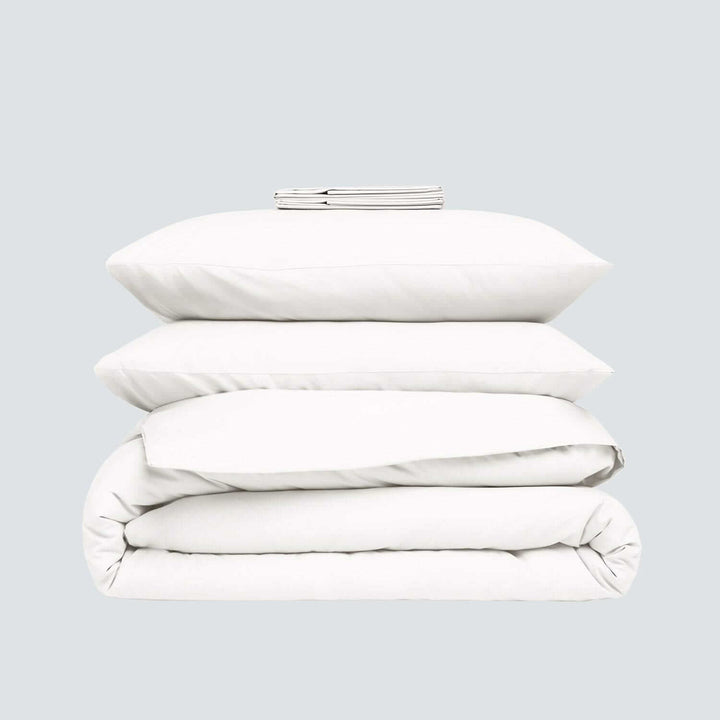
$598.40
$748.00
Cooler Nights & Deeper Sleep — Every Night Elevate your sleep with the only sustainable bundle crafted from regenerative New Zealand wool and organic cotton for true all-season comfort. These breathable, eco-friendly fibers naturally wick away heat and moisture to… Read more
Why Wool Is the Real Deal: Understanding Wool Comforter Benefits
If down alternative is the shower curtain of bedding, wool is the non-toxic comforter that provides the cozy embrace of nature. Here’s why wool comforter benefits outperform down alternative in every way:
- Temperature Regulation: A wool comforter is a natural insulator. It keeps you cool when it’s hot and warm when it’s cold, ensuring you sleep comfortably all year round. Wool fibers wick moisture away from your body, so you’ll never wake up clammy.
- Breathability: Unlike synthetic fibers, wool allows air to circulate freely, creating a balanced sleep environment. Your body can release heat and moisture without getting trapped under the covers.
- Hypoallergenic and Chemical-Free: A wool comforter is naturally resistant to dust mites, mold, and bacteria. With wool, you don’t need to worry about the toxic chemicals often used to manufacture down alternative products.
- Eco-Friendly: At Antipodean Home, our wool is sourced from regenerative farms in New Zealand, meaning it’s not just better for your sleep but also better for the planet. Plastic-based down alternatives, on the other hand, contribute to microplastic pollution and harm ecosystems. By choosing natural wool, you are accessing the full list of wool comforter benefits—from better sleep to a better planet.
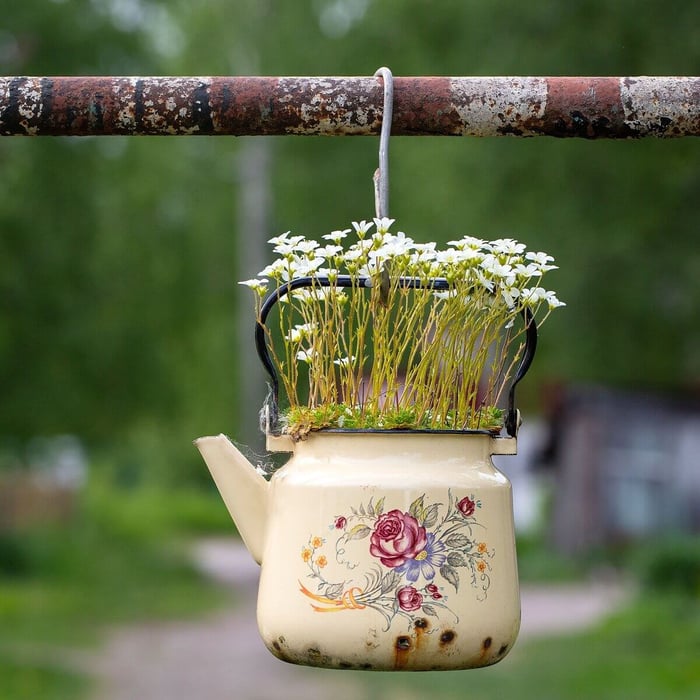 Antipodean Home sources its materials from regenerative farms
Antipodean Home sources its materials from regenerative farmsPlastic Is Ruining Your Sleep (and Your Home)
Your home should be a sanctuary—a place to recharge and refresh. But when you bring plastic into your bedroom, you’re not just compromising your sleep; you’re inviting toxins and synthetic materials into a space meant for rest. It’s time to get plastic out of your home, starting with your bedding. This is, in part, why down alternative is ruining your sleep.
Choosing wool over down alternative isn’t just about improving your sleep (though it will); it’s about choosing authenticity over imitation. Wool is the real deal—a material designed by nature to provide the deep, restorative sleep you deserve.
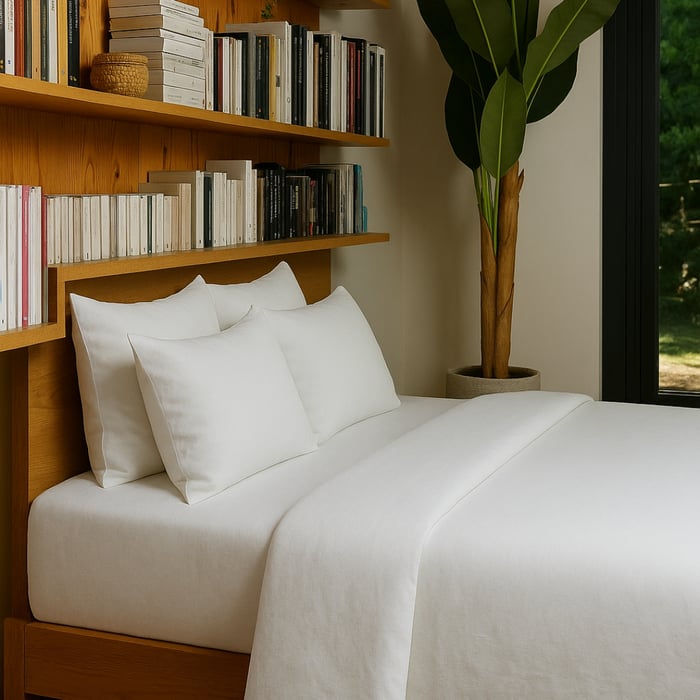 Organic Wool Comforter | Antipodean Home
Organic Wool Comforter | Antipodean HomeReal Sleep Comes from Real Materials
When it comes to your bedding, don’t settle for plastic in disguise. Down alternative might be cheaper upfront, but the cost to your sleep and your health is far too high. And it may be why down alternative is ruining your sleep. Wool, on the other hand, delivers a sleep experience that’s natural, breathable, and sustainable—every single night.
So, why sleep under a shower curtain when you can experience the luxury of wool? Make the switch today and discover the Antipodean difference: real sleep, with real materials, for real rest.
If you’re ready to elevate your sleep, and try a reliable polyester comforter alternative, check out our organic wool comforters. Made in New Zealand with ZQ-certified regenerative wool, they’re designed to give you the restorative rest you’ve been dreaming of.
🌿 Read more about how we source Regenerative Wool.
💧 Discover why wool helps regulate temperature for Hot Sleepers
Shop Our Organic Wool Comforter
FAQs on Wool Duvet Inserts, Comforters & Sustainable Bedding
Is down alternative toxic?
Down alternative is usually made from polyester and other synthetic microfibers. These can be treated with chemicals such as flame retardants or coatings that may off-gas VOCs (volatile organic compounds). While not always labeled “toxic,” these synthetics can release unwanted chemicals into your sleeping environment and are less healthy than natural bedding.
What is down alternative made of, and how does it compare to wool?
Wool comforters are naturally breathable and moisture-wicking, keeping you cool in summer and warm in winter. Synthetics like down alternative trap heat and moisture, leading to night sweats and restless sleep.
Most down alternative comforters and pillows are filled with polyester fibers designed to mimic goose or duck down. Unlike wool, polyester doesn’t breathe or wick moisture — it traps heat and humidity, which often leads to night sweats. Wool fibers, on the other hand, naturally regulate temperature and are renewable and biodegradable.
Is down alternative really hypoallergenic?
While often marketed as hypoallergenic, many down alternative comforters are made from polyester or microfiber, which can trap dust, bacteria, and odors. Organic wool is naturally resistant to dust mites and mold without chemicals.
Why does down alternative make me sweat at night?
Down alternative fibers don’t regulate temperature — they hold heat and moisture close to your body. Wool fibers, on the other hand, absorb excess moisture and release it into the air, preventing overheating.
Synthetic fibers like polyester don’t allow airflow or moisture transfer. As your body releases heat and humidity during sleep, the filling holds it in, creating a clammy microclimate under the covers. Wool fibers breathe and release moisture, keeping you cooler and drier throughout the night.
Are wool comforters eco-friendly compared to down alternative?
Yes. Organic and regenerative wool comforters are biodegradable and sourced from low-impact farms, while down alternative is petroleum-based plastic that contributes to landfill waste.
How long do wool comforters last vs down alternative?
Absolutely. A well-cared-for wool comforter can last 10+ years without clumping or flattening. Down alternative often loses loft quickly and needs replacing every few years.
Down alternative comforters, made with polyester, often lose loft and insulation within 2–3 years, requiring frequent replacement. Wool is more durable, sustainable, and a better long-term investment.
What does down alternative mean?
“Down alternative” is a marketing term for synthetic bedding designed to replicate the loft of down. It’s typically made from polyester and positioned as hypoallergenic and budget-friendly. However, it lacks the breathability, moisture control, and sustainability of natural wool.


